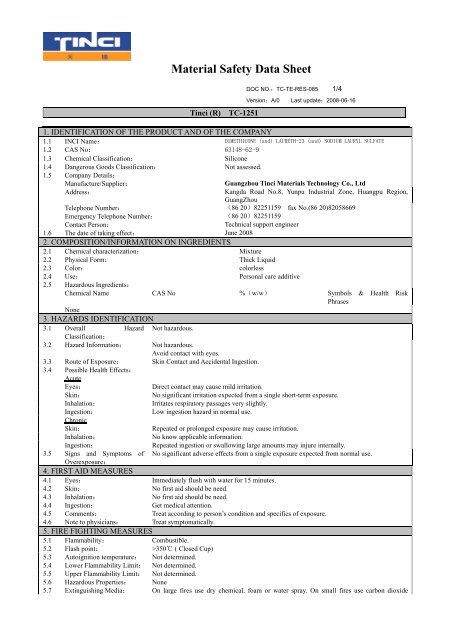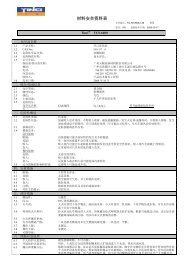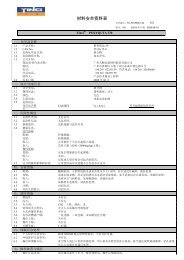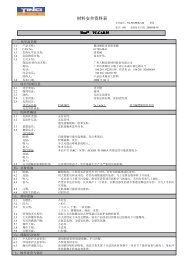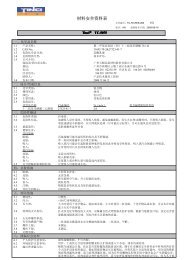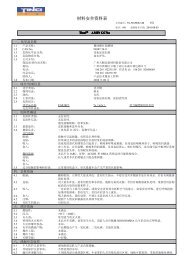Material Safety Data Sheet
Material Safety Data Sheet
Material Safety Data Sheet
You also want an ePaper? Increase the reach of your titles
YUMPU automatically turns print PDFs into web optimized ePapers that Google loves.
<strong>Material</strong> <strong>Safety</strong> <strong>Data</strong> <strong>Sheet</strong><br />
DOC NO.:TC-TE-RES-085 1/4<br />
Tinci (R) TC-1251<br />
Version:A/0<br />
Last update:2008-06-16<br />
1. IDENTIFICATION OF THE PRODUCT AND OF THE COMPANY<br />
1.1 INCI Name: DIMETHICONE (and) LAURETH-23 (and) SODIUM LAURYL SULFATE<br />
1.2 CAS No: 63148-62-9<br />
1.3 Chemical Classification: Silicone<br />
1.4 Dangerous Goods Classification: Not assessed.<br />
1.5 Company Details:<br />
Manufacture/Supplier:<br />
Address:<br />
Guangzhou Tinci <strong>Material</strong>s Technology Co., Ltd<br />
Kangda Road No.8, Yunpu Industrial Zone, Huangpu Region,<br />
GuangZhou<br />
Telephone Number: (86 20)82251159 fax No.(86 20)82058669<br />
Emergency Telephone Number: (86 20)82251159<br />
Contact Person:<br />
Technical support engineer<br />
1.6 The date of taking effect: June 2008<br />
2. COMPOSITION/INFORMATION ON INGREDIENTS<br />
2.1 Chemical characterization: Mixture<br />
2.2 Physical Form: Thick Liquid<br />
2.3 Color: colorless<br />
2.4 Use: Personal care additive<br />
2.5 Hazardous Ingredients:<br />
Chemical Name CAS No %(w/w) Symbols & Health Risk<br />
Phrases<br />
None<br />
3. HAZARDS IDENTIFICATION<br />
3.1 Overall Hazard Not hazardous.<br />
Classification:<br />
3.2 Hazard Information: Not hazardous.<br />
Avoid contact with eyes.<br />
3.3 Route of Exposure: Skin Contact and Accidental Ingestion.<br />
3.4 Possible Health Effects:<br />
Acute<br />
Eyes:<br />
Direct contact may cause mild irritation.<br />
Skin:<br />
No significant irritation expected from a single short-term exposure.<br />
Inhalation:<br />
Irritates respiratory passages very slightly.<br />
Ingestion:<br />
Low ingestion hazard in normal use.<br />
Chronic<br />
Skin:<br />
Repeated or prolonged exposure may cause irritation.<br />
Inhalation:<br />
No know applicable information.<br />
Ingestion:<br />
Repeated ingestion or swallowing large amounts may injure internally.<br />
3.5 Signs and Symptoms of No significant adverse effects from a single exposure expected from normal use.<br />
Overexposure:<br />
4. FIRST AID MEASURES<br />
4.1 Eyes: Immediately flush with water for 15 minutes.<br />
4.2 Skin: No first aid should be need.<br />
4.3 Inhalation: No first aid should be need.<br />
4.4 Ingestion: Get medical attention.<br />
4.5 Comments: Treat according to person’s condition and specifics of exposure.<br />
4.6 Note to physicians: Treat symptomatically.<br />
5. FIRE FIGHTING MEASURES<br />
5.1 Flammability: Combustible.<br />
5.2 Flash point: >350℃ ( Closed Cup)<br />
5.3 Autoignition temperature: Not determined.<br />
5.4 Lower Flammability Limit: Not determined.<br />
5.5 Upper Flammability Limit: Not determined.<br />
5.6 Hazardous Properties: None<br />
5.7 Extinguishing Media: On large fires use dry chemical, foam or water spray. On small fires use carbon dioxide
<strong>Material</strong> <strong>Safety</strong> <strong>Data</strong> <strong>Sheet</strong><br />
DOC NO.:TC-TE-RES-085 2/4<br />
Tinci (R) TC-1251<br />
Version:A/0<br />
Last update:2008-06-16<br />
5.8 Special Fire Fighting<br />
Procedures and Equipment:<br />
5.9 Hazardous Combustion<br />
Products:<br />
5.10 Unsuitable Extinguishing<br />
Media:<br />
(CO2), dry chemical or water spray. Water can be used to cool fire exposed containers.<br />
Self-contained breathing apparatus and protective clothing should be worn in fight large fires<br />
involving chemicals. Determine the need to evacuate or isolate the area according to your<br />
local emergency plan. Use water spray to keep fire exposed containers cool.<br />
Silicon dioxide. Carbon oxides and traces of incompletely burned carbon compounds. Metal<br />
oxides. Sulfur oxides. Nitrogen oxides. Formaldehyde.<br />
None established.<br />
6. ACCIDENTAL RELEASE MEASURES<br />
6.1 Personal Precaution: Avoid eye contact. Do not take internally.<br />
6.2 Environmental Precautions: Prevent from spreading or entering into drains, ditches or rivers by using sand, earth or other<br />
appropriate barriers.<br />
6.3 Methods for Cleaning up: Determine whether to evacuate or isolate the area according to your local emergency plan.<br />
Observe all personal protective equipment recommendations described in this MSDS. If<br />
diked material can be pumped, store recovered material in appropriate container. Clean up<br />
remaining materials from spill with suitable absorbant. Clean area as appropriate since some<br />
silicone materials, even in small quantities, may present a slip hazard. Final cleaning may<br />
require use of steam, solvents or detergents. Dispose of saturated absorbant or cleaning<br />
materials appropriately, since spontaneous heating may occur. Laws and regulations may<br />
apply to releases and disposal of this material, as well as those materials and items employed<br />
in the cleanup of releases. You will need to determine which laws and regulations are<br />
applicable.<br />
7. HANDLING AND STORAGE<br />
7.1 Handling: Use with adequate ventilation. Avoid eye contact. Do not take internally. Exercise good<br />
industrial hygiene practice. Wash after handling, especially before eating, drinking or<br />
smoking<br />
7.2 Storage Conditions: Use reasonable care and store away from oxidizing materials.<br />
7.3 Unsuitable Packaging<br />
<strong>Material</strong>s:<br />
None established<br />
8. EXPOSURE CONTROLS/PERSONAL PROTECTION<br />
8.1 Industrial Hygiene<br />
Standards<br />
Ingredients CAS No. Exposure Limits<br />
None known.<br />
8.2 Engineering Controls:<br />
Local Ventilation:<br />
General Ventilation:<br />
8.3 Personal Protective<br />
Equipment for Routine<br />
Handling<br />
Respiratory protection:<br />
Suitable Respirator:<br />
Eye protection:<br />
Hand protection:<br />
Skin protection:<br />
Hygiene Measures:<br />
8.4 Personal Protective<br />
Equipment for Spills<br />
Respiratory protection:<br />
Eye protection:<br />
Recommended.<br />
Recommended.<br />
Use respiratory protection unless adequate local exhaust ventilation is provided or air<br />
sampling data show exposures are within recommended exposure guidelines. Industrial<br />
Hygiene Personnel can assist in judging the adequacy of existing engineering controls.<br />
Dust/Mist Type.<br />
Use proper protection—safety glasses as a minimum.<br />
No special protection needed.<br />
Washing at mealtime and end of shift is adequate.<br />
Exercise good industrial hygiene practice. Wash after handling, especially before eating,<br />
drinking or smoking.<br />
Use respiratory protection unless adequate local exhaust ventilation is provided or air<br />
sampling data show exposures are within recommended exposure guidelines. Industrial<br />
Hygiene Personnel can assist in judging the adequacy of existing engineering controls.<br />
Use proper protection—safety glasses as a minimum.
<strong>Material</strong> <strong>Safety</strong> <strong>Data</strong> <strong>Sheet</strong><br />
DOC NO.:TC-TE-RES-085 3/4<br />
Tinci (R) TC-1251<br />
Version:A/0<br />
Last update:2008-06-16<br />
Skin protection:<br />
Washing at mealtime and end of shift is adequate.<br />
Precautionary Measures: Avoid eye contact. Do not take internally. Use reasonable care.<br />
9. PHYSICAL AND CHEMICAL PROPERTIES<br />
9.1 Physical Form: Liquid<br />
9.2 Color: colorless<br />
9.3 Odor: Odorless<br />
9.4 pH Not determined.<br />
9.5 Flash Point: >350 ℃ (Closed Cup)<br />
9.6 Explosive properties: No<br />
9.7 Oxidizing properties: No<br />
9.8 Flammability: Combustible.<br />
9.9 Specific Gravity: 0.97<br />
9.10 Viscosity(25 ℃ mpa·s): 400000-850000<br />
The above information is not intended for use in preparing product specifications. Contact Tinci before writing specifications.<br />
10. STABILITY AND REACTIVITY<br />
10.1 Stability: Stable.<br />
10.2 Reactivity:<br />
Conditions to Avoid: None.<br />
<strong>Material</strong>s to Avoid: Oxidizing material can cause a reaction.<br />
Hazardous Decomposition Silicon dioxide. Carbon oxides and traces of incompletely burned carbon compounds. Metal<br />
Products:<br />
oxides. Sulfur oxides. Nitrogen oxides. Formaldehyde.<br />
Hazardous Polymerization: Hazardous polymerization will not occur.<br />
11. TOXICOLOGICAL INFORMATION<br />
11.1 Possible Health Effects: Refer to Section 3.4<br />
11.2 Sensitizing Effects: None know.<br />
11.3 Mutagenic Effects: None know.<br />
11.4 Reproductive Effects: None know.<br />
11.5 Carcinogenic Effects: None know.<br />
11.6 Other Health Hazard None know applicable information.<br />
Information:<br />
12. ECOLOGICAL INFORMATION<br />
12.1 Environmental Fate and Siloxanes are removed from water by sedimentation or binding to sewage sludge. In soil,<br />
Distribution:<br />
siloxanes are degraded.<br />
12.2 Environmental Effects:<br />
No adverse effects on<br />
aquatic organisms.<br />
Bioaccumulation:<br />
No bioaccumulation potential.<br />
12.3 Fate and Effects in Waste<br />
Water Treatment Plants:<br />
Removed >90% by binding onto sewage sludge. No adverse effects on bacteria. The<br />
siloxanes in this product do not contribute to the BOD.<br />
12.4 Additional Environmental<br />
Information:<br />
Degradation:<br />
Additional environmental information on the silicone component is available on request.<br />
13. DISPOSAL CONSIDERATIONS<br />
13.1 Product Disposal: Dispose of in accordance with local regulations.<br />
13.2 Packaging Disposal: Dispose of in accordance with local regulations.<br />
14. TRANSPORT INFORMATION<br />
14.1 Road and Rail Transport: Not assessed.<br />
14.2 Sea Transport(IMDG): Not subject to IMDG code.<br />
14.3 Air Transport(ICAO): Not subject to ICAO regulations.<br />
15. REGULATORY INFORMATION<br />
15.1 Applicable Laws: Provisions of the Regulations for the Safe Handling of Chemicals in the Workplace,<br />
particularly those relating to the safe use, production, storage and transportation of dangerous<br />
chemicals.<br />
15.2 Chemical Inventories:
<strong>Material</strong> <strong>Safety</strong> <strong>Data</strong> <strong>Sheet</strong><br />
DOC NO.:TC-TE-RES-085 4/4<br />
Tinci (R) TC-1251<br />
Version:A/0<br />
Last update:2008-06-16<br />
AICS:<br />
All ingredients listed or exempt.<br />
DSL:<br />
All chemical substances in this material are included on or exempted from the DSL.<br />
IECSC:<br />
All ingredients listed or exempt.<br />
MITI:<br />
All components are listed on ENCS or its exempt rule.<br />
KECL:<br />
All ingredients listed, exempt or notified.<br />
EINECS:<br />
All ingredients listed or exempt.<br />
PICCS:<br />
All ingredients listed or exempt.<br />
TSCA:<br />
All chemical substances in this material are included on or exempted from listing on the<br />
TSCA Inventory of Chemical Substances.<br />
16. OTHER INFORMATION<br />
Contact Point: Technical Services Engineer (86 20)82251159<br />
Prepared by:<br />
Guangzhou Tinci <strong>Material</strong>s Technology Co., Ltd<br />
This information is offered in good faith as typical values and not as a product specification. No warranty, expressed or implied, is<br />
hereby made. The recommended industrial hygiene and safe handling procedures are believed to generally applicable. However,<br />
each user should review these recommendations in the specific context of the intended use and determine whether they are<br />
appropriate.<br />
® Indicates Registered Trademark


